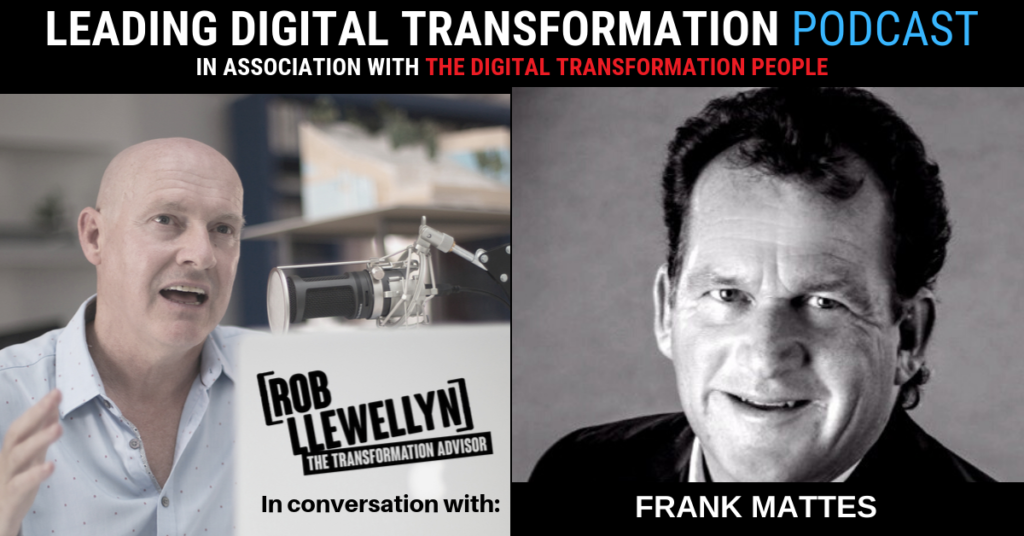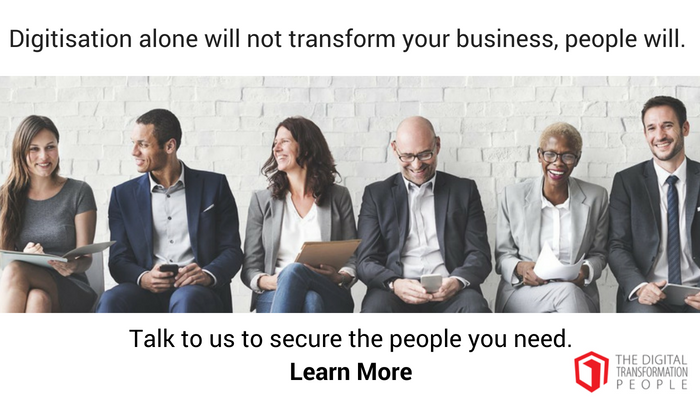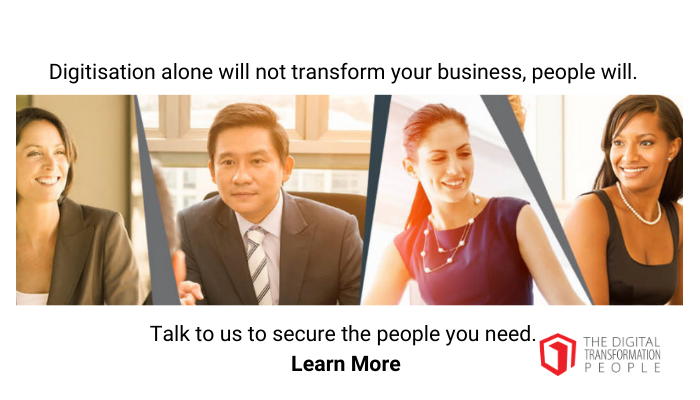‘Leading Digital Transformation’ is a weekly podcast series produced in collaboration between The Digital Transformation People and Rob Llewellyn digital transformation advisor and founder of CXO Transform.
During this series, Rob interviews experienced practitioners, authors and thought leaders whose stories and experiences provide valuable insights for digital transformation success.

In this episode, Rob interviews Frank Mattes, co-author of the acclaimed book ‘Scaling Up’ in which he and Dr Ralph Christian Ohr present a unique framework called Dual Innovation to help address the difficulties many corporates encounter when trying to realise business impact from their non-incremental innovation initiatives.
“Typically, companies have little problems in generating ideas for adjacent, radical or even disruptive innovation and in validating the most promising ideas. On the other end of the process, companies have systems to grow material businesses and incrementally improve their performance over time. But for many companies, the transitional Scaling-Up phase in-between is a ‘Valley-Of-Death’, in which many promising concepts die on their journey from idea to business impact.”
~ Frank Mattes
Listen here and read the full transcript below.
Rob Llewellyn [00:00:00] Hello and welcome. Today I’m joined by Frank Mattes from Germany. Frank’s a leading expert on scaling-up corporate start-ups and he’s written the first book on the subject. Together with his clients which are Fortune 10 to Fortune 200 companies and those companies are widely seen as innovation leaders. Let’s jump into the interview with Frank.
Rob Llewellyn [00:00:22] Frank welcome to the podcast.
Frank Mattes [00:00:25] Thanks for having me, Rob. Good morning to you.
Rob Llewellyn [00:00:28] Good morning.
Rob Llewellyn [00:00:29] So, Frank before I kick off I’ve got a lot of questions I want to ask you today. You’ve written a book it’s called Scaling up Corporate Start-ups. And I’m sure we’ll touch on some of the concepts as we go through our conversation. But tell us about the book. Why you wrote the book and how that came about.
Frank Mattes [00:00:46] What I and the consulting company innovation-3 that I founded are doing is non-incremental innovation. It started off some years ago when open innovation became mainstream. Four years ago, that open went digital so to say. Companies were discussing Blockchain and Artificial Intelligence and these kinds of things.
Some two years ago or so I noticed a common theme. So if you will, I heard the same song over and over again, As an innovator you are interested in patterns, right? Because there might be opportunities. The song that I heard is: ‘Well, Frank, we do have our digital labs, our digital factories, our accelerators, incubators, innovation centres etc. Smart people in there. We do not lack ideas and we kind of know how to validate them using the Lean Startup or other methodologies. But where’s the business impact?
So, after hearing that story over and over again across industries, from the very large companies to the ones that are in a single-digit Billion size, I thought there seems to be a problem worth to be solved there – And this is the point where the innovation journey starts. I looked around, and I could not find any guidance for corporate practitioners on how to address this problem. There was quite some stuff out there that deals with greenfield start-ups. Stuff like how do you found your company, how do you grow your greenfield start-up and how to negotiate with venture capitalists? But that does not translate to corporate start-ups which are kind of specific, so to say. I’m sure that we’ll touch on that later on.
So what I did is I assembled a group of some 15 or so companies. We spent three workshops and a couple of WebExs to really define the problem and then some more workshops and WebExs to work out the solution. And we all felt it might be a good idea to contribute to the body of knowledge by having that in the form of the book. So it’s a summary if you will where ‘next practice’ will be. There is no ‘best practice’ out there, it is only an ’emerging’ or ‘next practice’ if you will, but it’s also an outlook into how to solve a big, big problem.
There are statistics out there saying only 1 out of 8 corporate start-ups make it to success. And another statistic saying, that the Fortune 1000 spend in the last five year on innovation is comparable to the German GDP which is the fourth largest in the world and actually the Return On Innovation is decreasing.
So there is a massive, massive problem out there. And so far there has not been a kind of guidance on how to deal with it. We felt it might be really adding value to the discussion.
Rob Llewellyn [00:04:05] Okay. And in fact, the book is called Scaling up Corporate Start-ups. Now we’ve got a lot of listeners out there and everybody’s got their different views and perspectives. What is scaling-up in your definition, and why should companies care about it?
Frank Mattes [00:04:25] Innovation is about capturing business impact from something new. Let’s leave it like this for the time being. So it’s the business impact that we’re interested in. And if you look at an end-to-end innovation process you start off with some insights where things are going, where markets are going, the opportunities that digital is offering, some threats from new market entrants, these kinds of things. Then you drum out ideas on how to capitalise on these things and you check – or ‘validate’ as the experts say: Which of those ideas have a problem-solution fit and later on product-market fit?
At the other end of the process, you’ll find that many companies know how to grow a let’s call it ‘sizable business’. So imagine if they buy a digital start-up and the start-up has some millions of revenues and some technology and a customer base, the corporates know how to take it from there. But in-between these two corners, there’s a gap. And the gap is basically taking validated innovation concepts to a meaningful sizable business, from which it can be picked up by corporate. And this is what we call ‘Scaling-Up’.
If you look at it, there are a couple of reasons why companies need to address that Scaling-Up issue. First of all, as I mentioned earlier, there are some statistics out there showing that companies are not good at it. So if only one out of eight corporate start-ups make it, you’re talking about a failure rate of 87 per cent. I mean this is not to be accepted, right?
Then secondly, if you’re having a closer look at it, the future company is basically shaped by two things. The one is the, as we call it ‘Adaptation of the Core’. This is where the application of digital technologies play out. So think about a manufacturing company selling widgets. Now they go for a widget-as-a-service using remote monitoring and predictive maintenance plays – these kinds of things. Or obviously, you establish new levels of consumer customer insight using advanced analytics, these kinds of things. So ‘Adapt the Core’ is one part that makes building the future company. But the other thing is scaling-up those ventures that are building on a new-to-the-company technology which is being industrialized. Think about, say changing to smart contracts on the blockchain and automating the full process. This might be in many instances completely new-to-the-company. Or establishing completely new business models which need to be scaled-up. So if you take these two things, ’Adapting the Core’ with Digital plus scaling-up those radical digital innovations and digitally-enabled business models – This is what makes up the future company. Hence companies need to be excellent in both of these things.
Rob Llewellyn [00:07:51] Frank you kind of touched on the fact that not all companies are getting this right. In fact, a lot of companies are getting it quite wrong. What in general is the level of excellence in scaling-up that you see in companies from working with clients?
Frank Mattes [00:08:07] We do have half of the German prime stock index on our client list and we are also working with large companies in core Europe. Within our client base, I would say that we can call only a quarter or so to be ‘excellent in Scaling-Up’. There’s a growing awareness out there, and companies are feeling the pain-point that they do not get the Return On Innovation from non-incremental innovation. But if you ask me for excellence, the journey has just started and I think that in the next one to two years we will see much more thinking going into how to solve that corporate Scaling-Up problem.
Rob Llewellyn [00:08:56] And is there some kind of quick test that a company can do to assess where they’re at in terms of their scaling-up excellence?
Frank Mattes [00:09:05] One thing that I can think of and this might be also a discussion starter, so to say: You ask, ‘well if you look at your non-incremental innovation, meaning not the small stuff of improvements, how much money did you invest some three to five years ago?’ And if you look at what you did three to five years ago what’s the return that you get out of there?
Because three to five years is the typical time-to-impact for non-incremental innovation. If you’re going fully radical, this might even be five to 10 years. But most of the companies only have very few moon shots. The majority is played out in an adjacent space. So to give you one figure –obviously, I cannot mention the client and the real figures – but just to give you some idea of the size of the problem: Three to five years ago they invested one hundred. And if they look at the return they are getting from what they did three to five years ago, they are talking about seven. So huge money burned. And this is a typical example. Companies are only starting to wake up to that Scaling-Up challenge.
Rob Llewellyn [00:10:27] So you think it’s mandatory that companies become excellent in scaling up?
Frank Mattes [00:10:31] If I may revert back to what I said a couple of sentences ago shaping the company’s future is one part of the story.
Besides adapting the core it’s about that financial dimension that we just spoke about.
But I mean there’s also a war for talent out there isn’t that so? And if a company is not showing that it is able to scale up those great ideas, the best people might say ‘My company doesn’t get it’. So, they might be heading off for some other companies.
Plus obviously, there’s also a stock market implication if your company is publicly listed. There is only so much organic growth that you can generate from the existing business model. So you need to look for other growth areas which will be adjacent or even completely radical.
So yes, it is imperative.
Rob Llewellyn [00:11:36] And how should companies approach their challenge of getting better at scaling up?
Frank Mattes [00:11:44] OK. So the first thing you need to do is to understand and acknowledge that there is a problem like the one hundred to seven figures that I mentioned.
And the second thing is to get a clearer understanding of where this problem comes from and what is validated cornerstones for a solution.
Let me elaborate shortly on where the problem comes from. Many companies have quite rightly separated the non-incremental innovation from the day to day business. So they built their digital labs, digital factories, accelerators incubators, etc. Which is good because you find that core company – the day-to-day business – runs on a different paradigm than these exploitative innovation units. Core business runs on the process, zero mistakes, managing risk top-down planning and these kinds of things. Whereas, if you’re in the explorative innovation space, you’re basically in an agile way developing where you want to go and how to get there.
And if you imagine that these two parts are under one roof, you’ll find that you need to have some sort of gearbox that connects the engine of the day-to-day business with the engine of the explorative, innovation units. If you don’t do that, you will run into what we called ‘Areas Of Tension’. You find at least ten points where these two organisations – the day-to-day business and the corporate start-up –do not match.
So you need to make it match. And here comes what we worked out in that group of companies which-, which has also been put into that book. You need to master three things.
Frank Mattes [00:13:40] Firstly, you need to be much more rigorous in validating your innovation concept than you ever do for a greenfield start-up. Why? As a greenfield start-up, say some digital start-up trying to come up with the latest and greatest in Blockchain or crypto-currency or whatever it is, you have the right to pivot, right? So if you find at some point in time that the business model that you were up to does not work, well, you might change that. And there are some famous stories out there like Twitter or Slack – they all started off somewhere else than where they are right now. As a corporate start-up, you do not have these degrees of freedom to pivot. Why? Because you’re working in a corporate context that supposes that a corporate start-up has to deliver one piece of the strategic innovation agenda. So number one, you have to be much more rigorous. And in the book, you’ll see what we’ve worked out in that cross-industry group to be a solid, reliable, robust validation framework.
Frank Mattes [00:14:47] The second piece of the solution is what we call Dual Leadership. Now, leadership plays a crucial role in here since they need to balance the requirements of the day-to-day business – Optimising the core, optimise the existing – while at the same time creating the new. So, balancing these two kind of companies that are running on different paradigms, as I just said, and making the tough decisions on what to fund, how much to fund and where to put key people in – These kind of decisions puts a lot of challenge for leaders to get it right. To establish what we call dual leadership, is the second part.
Frank Mattes [00:15:36] The third part is a new style of working and a new style of management. Because the trick is to leverage the corporate assets –which could be the customer base, production facilities, access to customers, access to industry influencers, a lot of in-house experts etc. –while at the same time remain in speedboat mode. There are some tangible points where you can build up that bridge or the ‘gearbox’ as I just called it, by establishing the proper way of funding, by clever design of the Scaling-Up process, by establishing the right governance, by choosing the right KPIs and metrics etc to make that work.
So to summarise: A very rigorous –even more rigorous validation than you do for greenfield start-ups, plus Dual Leadership plus a new style of working/management.
Rob Llewellyn [00:16:40] Frank, you touched on some of the success factors such as governance, KPIs, and other things just then. If you were to provide a short list of key factors for success in scaling up, that leaders can keep their eye on, what would that list look like?
Frank Mattes [00:16:57] It starts off obviously with some assessment on where things are going. There seem more and more companies being aware that industries are converging. Many companies are not speaking about industries anymore, they are speaking about ‘arenas’ in where you find competitors that historically were in totally different industries. What is emerging is so complex that the traditional strategy processes do not work anymore. So what they do is they paint ‘Pictures of the Future’ together also with external experts to understand where potential arenas for these type of non-incremental innovation would be.
Second is to encourage an agile way of exploring where value pools in these new arenas might be that are suitable for the company.
Thirdly, is encouraging that this thorough and rigorous validation is done. This implies that some things will not work out in the first run, right? You have to go back and forth until you find a problem/solution-fit and a product/market-fit but that requires from leaders to accept that this is not a process model that they are working in, this is an agile model.
Next would be to set up for success when it comes to funding. An emerging practice that we have found – since funding is always an issue for these ventures – is to say the minute that we decide that this is a validated innovation concept that should be taken to scale, we earmark the whole funding for the whole process. And even if big corporate has two bad quarters this funding is earmarked because there is no point in stopping along the way. What you do in designing the process is you design it in a kind of VC -type. So you define milestones that relate to how you get on with industrialising the product, making the market and growing the organisation of the corporate start-up. And once you hit those milestones the next level of funding is released.
Next thing is there are only a few critical experts typically in the company. And it’s a tough decision to make if they should be working into the day-to-day business or they should be seconded on a temporary basis to that of a corporate start-up to leverage the unfair advantage.
So these are the kinds of decisions to be made. And at the end of the day, it’s also about being aware and taking middle management along that this corporate start-up is not just a fancy hobby but is about building a part of the future company. So getting alignment from the middle management ranks, from the current core which will be reshaped in the three to five years that we mentioned via scaling up these corporate start-ups and via adaptation of the core.
Rob Llewellyn [00:20:25] Frank. Some of our listeners are going to be already involved in scaling up and others might be considering diving into this. What are some practical steps that people who are-, who want to get involved can take and people who are already involved can take to scale up in a better way?
Frank Mattes [00:20:45] Maybe the first thing is to convince yourself that if you’re in the say 25 per cent of companies which are actually already excellent in scaling up – which we earlier said is mandatory for future-proofing the company –or if you’re in the 75 per cent bucket so to say.
We found a good discussion starter in looking at typical problems that companies are facing and basically aligning at the management level that these problems are out there.
So let me just give you two examples. Typically you find that big corporate treats the corporate start-up or the corporate scale up like it were an established business. That means they set up governance, they do the annual funding and if big corporate has a bad quarter and costs need to be controlled – well, the corporate start-up needs to deliver its share of the cost saving as well, which obviously doesn’t work if you are in scaling up mode because then you are investing. Or another typical problem is that corporate start-ups are underfunded and under-resourced. So the key people in the corporate start-up are not only fighting for funding to secure the next year or so for the promising start-up, they are also trying to make ends meet with very few people and focus their attention to a big deal not on industrialising the product or making the market, but on somehow ‘muddling through’, let’s put it that way.
And if you’re more advanced on your journey, so if you think that your company belongs to the 25 per cent well I suggest that you look into the book what leading companies like BP, Robert Bosch, Phillips or Telefonica etc do in validating their concepts, in establishing Dual Leadership and in establishing a new style of work/management to kind of benchmark yourself. I am pretty sure you’ll find some points that you can sign off, but I’m also pretty sure – that’s our experience with every client —that you find some points where they say: Well we didn’t think about that, or we know that we’re not good at this point. So let’s take it on our agenda.
Rob Llewellyn [00:23:27] Frank, I know you can share insights from hours and from probably days but we need to wrap it up there!
Frank Mattes [00:23:32] Certainly could do Rob!
Rob Llewellyn [00:23:37] It’s been terrific Frank. But you know if our listeners want to learn more about some of the concepts you’ve been talking about some whereas one place you’d suggest they go to to find and to learn more.
Frank Mattes [00:23:48] So what I already put out there Rob, if you will, a synopsis of the insights and the knowledge that we generated in the group, you’ll find that on LinkedIn and it’s also been published on The Digital Transformation People. I highly recommend not for short-term purposes, or to put some halo around my head, but I really suggest that you dive into that book because it captures – and in the view of these companies also for the first time out there – some elements on what will be ‘best practice’ in some years now in scaling up. So by familiarizing yourself with the recipes for success that these fine companies are pursuing, you also improve. And I think we can provide the link on The Digital Transformation People platform so that you can have a look into the table of contents and some highlighted pieces of content in there.
Rob Llewellyn [00:24:54] Terrific. And just as a reminder for listeners the book is called “Scaling Up Corporate Start-Ups”. Frank, it’s been a real pleasure. Thank you so much for coming on and sharing some of your insights.
Frank Mattes [00:25:07] Pleasure’s mine Rob. Thanks for having me.
VO [00:23:36] We hope you enjoyed this episode of leading digital transformation with Rob Llewellyn and The Digital Transformation People. Visit The Digital Transformation People to secure the knowledge, talent and services you need for digital transformation success. To continue your journey as a certified transformation professional visit RobLlewellyn.com
Be sure to subscribe to the podcast and follow us on Twitter @TheDigitalTP and @RobertLlewellyn.
Article by channel:
Everything you need to know about Digital Transformation
The best articles, news and events direct to your inbox
Read more articles tagged: Business Model, Featured, Innovation, Strategy












